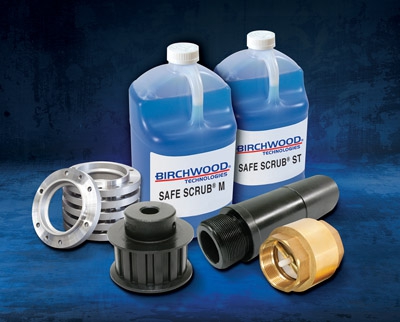
Two liquid cleaners developed by Birchwood Technologies can be used on a wide variety of process lines, including blackening, phosphating or electroplating lines. Safe Scrub M and Safe Scrub ST cleaners easily remove oil and surface soils on metal parts. These cleaners are effective biodegradable solutions that can be used on metal parts before or after processing.
Safe Scrub M and Safe Scrub ST are used to emulsify oil from aluminum, brass, copper, iron, and steel parts, and then hold residues in the solution to prevent them from re-depositing on the parts. Both cleaners effectively remove these types of fluids: mineral oil, grinding coolant, drawing/stamping lubes, and hydraulic oils, as well as water soluble/synthetic fluids. These products can be used as stand-alone cleaners after metalworking operations or as a precleaner prior to metal finishing operations.
Safe Scrub M is a non-caustic, mildly alkaline cleaner for use on aluminum, brass and copper components. Its mild formula cleans thoroughly without oxidizing or discoloring the substrate.
Safe Scrub ST is a heavy-duty liquid cleaner for use on iron and steel components. It has high oil-holding capacity and stability at high temperatures for super heavy-duty applications.
Safe Scrub M and Safe Scrub ST are environmentally friendly choices because they contain biodegradable surfactants and no chelating agents, which allows for easy disposal. They are supplied as concentrates that dissolve instantly in water to make the operating bath, and are then heated to 130-170 °F operating temperature. When the solutions are allowed to cool, much of the emulsified oil will float to the surface, allowing removal of the oil with an oil skimmer or coalescing filter and maximizing the working life of the Safe Scrub M and Safe Scrub ST cleaning solutions.
In general, liquid cleaners dissolve instantly and are easier and safer to utilize than powdered products, and are also more free-rinsing. They give the ability to produce clean surfaces that are receptive to subsequent coating and finishing operations.
Contact Details
Related Glossary Terms
- concentrates
concentrates
Agents and additives that, when added to water, create a cutting fluid. See cutting fluid.
- coolant
coolant
Fluid that reduces temperature buildup at the tool/workpiece interface during machining. Normally takes the form of a liquid such as soluble or chemical mixtures (semisynthetic, synthetic) but can be pressurized air or other gas. Because of water’s ability to absorb great quantities of heat, it is widely used as a coolant and vehicle for various cutting compounds, with the water-to-compound ratio varying with the machining task. See cutting fluid; semisynthetic cutting fluid; soluble-oil cutting fluid; synthetic cutting fluid.
- grinding
grinding
Machining operation in which material is removed from the workpiece by a powered abrasive wheel, stone, belt, paste, sheet, compound, slurry, etc. Takes various forms: surface grinding (creates flat and/or squared surfaces); cylindrical grinding (for external cylindrical and tapered shapes, fillets, undercuts, etc.); centerless grinding; chamfering; thread and form grinding; tool and cutter grinding; offhand grinding; lapping and polishing (grinding with extremely fine grits to create ultrasmooth surfaces); honing; and disc grinding.
- metalworking
metalworking
Any manufacturing process in which metal is processed or machined such that the workpiece is given a new shape. Broadly defined, the term includes processes such as design and layout, heat-treating, material handling and inspection.






